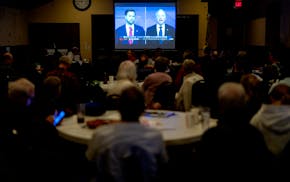A few years ago, Jolynn Good said, she found herself bothered by the way things seemed to be going in America. Like the taxes taken out of the bonus from her job at Old Navy. And how she was told not to say "merry Christmas" to the customers anymore. And why, Good wondered, did people think everything would just be handed to them without having to work for it?
She'd never had much time for politics. "I wanted nothing to do with it," Good said. Then Donald Trump came along.
"I didn't like all the things he said or how they came out. But it resonated. He was speaking to us," Good said last week at the Lakeville Republican field office, where she's been volunteering three days a week, making sure other volunteers are well-stocked with yard signs and campaign literature.
Good, 40, is the type of voter — from not very political to fervent Trump supporter — that helped propel him to the presidency. This year, with Trump not on the ballot but the direction of his next two years in office at stake, Republicans need these voters to come back to the polls on Tuesday if they are to hold off what Democrats hope will be a surge in voters motivated by opposition to Trump.
It won't be easy: Voter participation usually drops in midterm elections, especially among voters without a college degree, a key component of Trump's 2016 win. "Having these lower-propensity voters surge for Trump" was key to his victory, said Tom Bonier, the CEO of Washington-based TargetSmart, a data-intensive strategy firm that works with Democrats.
This was especially true in Upper Midwest states that the GOP flipped at the presidential level in 2016, like Michigan and Wisconsin. Trump came just shy of winning Minnesota, but his voters helped fuel Republicans' takeover of the state Senate and kept the Second Congressional District in the GOP fold.
For the midterms, Republicans have focused on finding these voters and getting them back to the polls, said Kevin Poindexter, executive director of the Minnesota Republican Party.
"We've had success bringing people into the field program who have never been involved in party politics," Poindexter said.
In the closing days of the midterm campaign, Trump himself has returned to an emphasis on immigration, an issue that has proved compelling to his strongest supporters. But he also helped state-level turnout efforts in a more concrete way, with his visits to Duluth and Rochester for campaign rallies this year — both in congressional districts that Republicans hope to flip from blue to red.
Between 30,000 and 40,000 people signed up to attend those rallies. Not all of them actually showed up, but the registration process gave the state GOP access to reams of data about potential voters and volunteers.
Party's '48-hour rule'
Poindexter instituted a "48-hour rule," requiring GOP staff to follow up with these Trump fans, make contact and sign them up to volunteer within two days. The party opened field offices all over the state to help organize their new foot soldiers.
With more volunteers, Republicans can knock on more doors, which is deemed far more effective for reaching voters than phone banks. "It's a complete culture change and a revamp of the ground game. Instead of paid staff, we have an army of volunteer true believers, which is even more powerful," Poindexter said.
An example: Ruth Benidt, a 73-year-old retired teacher from Rochester, who was in line for the evening Trump rally at 10:30 a.m.
"I'm not proud of it, but there were many years I didn't vote," Benidt said.
Then, in 2015, Benidt was watching TV. "I happened to see Melania and Donald Trump come down that escalator, and when he spoke, I said, 'You know what? He's talking to me.' "
Now Benidt knows all the Republican candidates, hands out literature and has a simple sales pitch in conversations with voters she thinks might hold similar views: "If you're a Trump supporter, [voting this year] is a way to say thank you for all the policies."
Good, the Lakeville volunteer, is doing even more. She has donated money to 15 candidates, marched in parades, hosted events for candidates, worked the booths at fairs and spread the word on social media. At times, she said, she's faced withering criticism from strangers and witnessed road rage by drivers who see her Trump sticker.
"I've been told 'you should be ashamed of yourself,' " said Good, a mother of five who started living on her own and supporting herself in high school.
The question is whether all of Trump's 2016 supporters will be as enthusiastic as Good is this year.
Jennifer Duffy, a senior editor at the Cook Political Report, said, "I'm more inclined to think a higher percentage will come out post-Kavanaugh than I did over the summer," referring to the confirmation hearing of Justice Brett Kavanaugh, which energized many Republicans to thwart Democratic efforts to take the U.S. Senate.
Still, Duffy is left to wonder: "Will they come out?"
Former DFL Senate Majority Leader Kari Dziedzic dies of cancer at age 62

How the Star Tribune is covering the 2024 election

Fact check: Walz and Vance made questionable claims during only VP debate

In Tim Walz's home city, opposing groups watch him debate on the national stage
